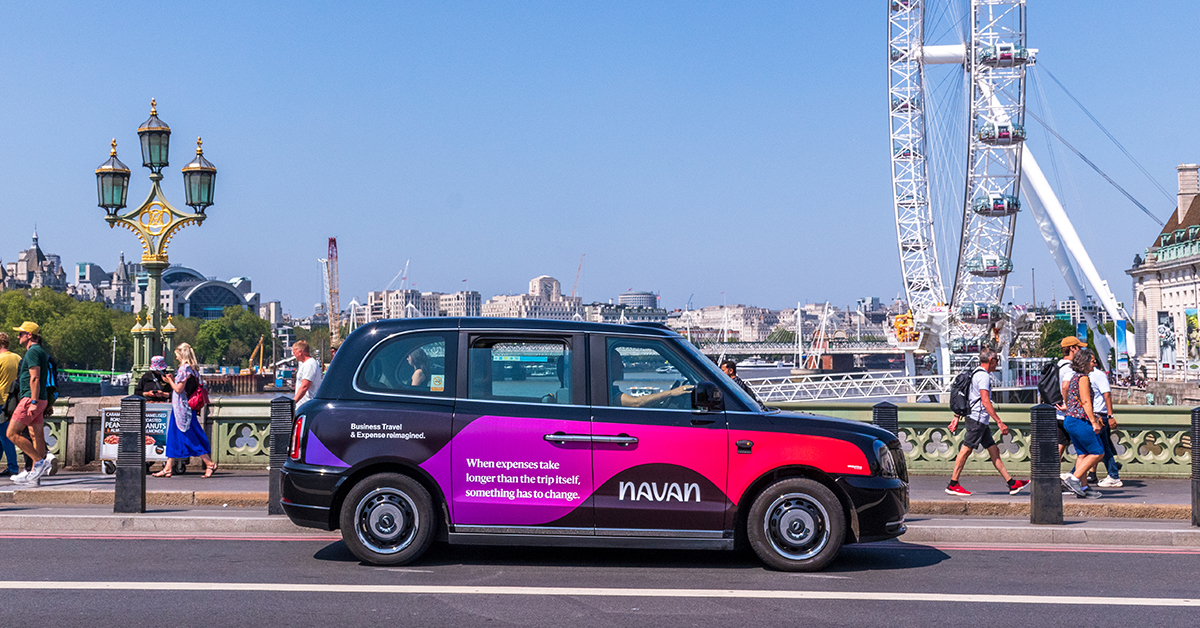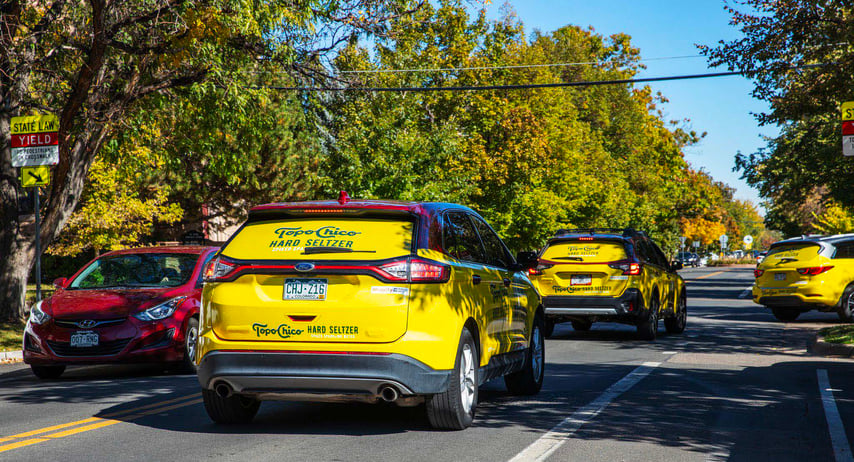
Have you ever seen an advertisement on top of a taxi or a rideshare vehicle wrapped in a brand’s ad? Like other forms of Transit advertising, Taxi and Rideshare advertising gets your message moving through communities and cities. A staple of advertising in large cities, such as NYC, Taxi and Rideshare advertising uniquely builds awareness.
In this article, you’ll learn all about Taxi advertising and Rideshare advertising. You’ll learn how it works, how to target audiences, what types of companies it works best for, and more.
Taxi advertising and Rideshare advertising are similar forms of Out-of-Home(OOH) advertising. They both involve placing ads on small vehicles. They target audiences from an external vantage point of those who see the car moving. They can also contain indoor ads to entice riders to interact with a brand.
Taxi and Rideshare advertising reaches broad audiences. This is especially true in cities where ride-sharing services are popular.
.jpg?width=911&height=607&name=How%20Taxi%20and%20Rideshare%20Advertising%20Works%201%20(2).jpg)
Taxis and Rideshare advertising provide many options for advertisers to spread their message throughout a market. Some of these options include:
A few other options are available, including wraps for other specific parts of the vehicle or branded accessories like seat covers. Options will depend on the specific ride-sharing service and the packages they offer. Las Vegas is one city that has interesting options because it has more independently owned taxi companies. In markets like New York City, when you buy interior media, you are buying that fleetwide rather than based on geolocation. This means that advertisers would be buying ads for every cab in the market that is in service and running their campaigns citywide.
There is little to no control over where the ads run for static advertisements. But wrapped taxis are often taken out of service. This makes them act much like Mobile Billboards. Advertisers can choose custom routes, build a swarm, or have a takeover that targets an event or location. A taxi swarm leverages a fleet of taxis as moving billboards to generate buzz, raise brand awareness, and reach a broad audience.
Lyft and Uber both allow rideshare advertisements. Uber and Lyft both offer rideshare advertisements through their companies. For more traditional taxi fleets and other rideshare, brands may sign up with a third-party company specializing in ride-share advertising, such as Firefly.
Advertisers choose the type or types of advertisement they will use. Then the advertising company finds ride-share drivers willing to have the ads installed on their vehicles. Ride-share drivers who sign up to drive ads around are paid, usually based on the number of miles they go with the ads on their cars.
The rideshare advertising companies each have their own rules and regulations. Please make sure your ads follow size and placement guidelines, as the ads will be subject to review and approval by the rideshare company.
Taxi and Rideshare advertising can be an effective way for brands to reach a broad audience. Targeting consumers on the move and in a captive environment helps reach and engage with potential customers.
.jpg?width=853&height=571&name=How%20Taxi%20and%20Rideshare%20Advertising%20Work%204%20(1).jpg)
The most common way to target audiences in Taxi and Rideshare advertising is geotargeting. Advertisers can target specific zip codes or areas to reach their audience. Rideshare advertising companies will provide data on how many trips are usually taken to a particular area. This gives advertisers an idea of how much of their target audience they may reach through their ads.
Geotargeting a location helps advertisers to reach specific demographics that live or travel to that area. For example, some sites may have more people who fit within a certain age, gender, or income.
Taxi/Rideshare advertising can work well for various businesses, but depending on the market, there may be a different approach. Taxi advertising for events or conferences might be more popular in some markets. But it may be part of a standard OOH media plan in other markets, such as New York City.
Taxi and Rideshare advertising works well for any brand that wants to take a geocentric approach. It is perfect for brands that want to build general awareness and branding.
It also doesn’t work for brands with a complicated campaign message because the message is moving. Ads should be designed for quick reads. Likewise, a campaign that leverages QR codes or where information needs to be written down will not work as well. Rideshare and Taxi advertising have short dwell times.

The success of Taxi and Rideshare advertising should be evaluated based on the specific goals of the campaign. These goals often use metrics such as reach, frequency or impressions. Before you begin your campaign, third-party ad providers for rideshare and tax vehicles will tell you where they see the most trips happening. They know what areas will have many taxi tops available and will serve you well for your campaign. After the campaign, they can tell you how many impressions were delivered and give you other details to help you measure your campaign’s success.
Rideshare and Taxi advertising gets you in the location that you want to be. It's a mobile way of amplifying any traditional media format in a specific vicinity. When the vehicle reaches a particular place, your ad will turn on to provide an added layer of awareness for people in that area. It pairs well with other transit options and large format advertisements as an incredible support to amplify your campaign. Ready to get your message on the move? Reach out to Billups today!
Don't worry—we won't share your information.